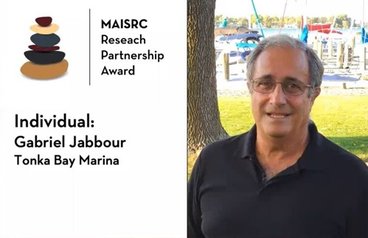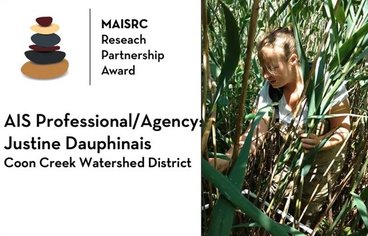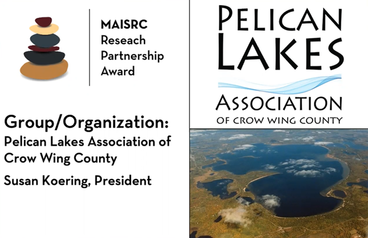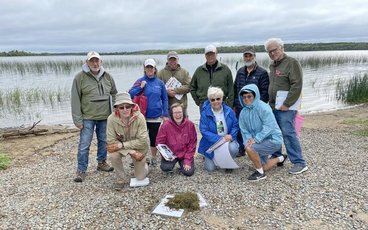
2021 Research Partnership Award Recipients Announced
Four individuals/organizations have been announced as the first ever cohort of the Minnesota Aquatic Invasive Species Research Center’s Research Partnership Award. The award recognizes people, groups, and organizations who have gone above and beyond to contribute to MAISRC's mission of advancing aquatic invasive species knowledge and inspiring action to protect and restore Minnesota’s beloved waters. Honorees include Gabriel Jabbour, Justine Dauphinais, Minnesota Lakes and Rivers Advocates (MLRA), and Pelican Lakes Association of Crow Wing County (PLA).
- MAISRC, housed at the University of Minnesota, has grown considerably since its creation in 2012. The Center strives to find real world solutions to reduce the impacts of aquatic invasive species on Minnesota’s cherished lakes, rivers, and wetlands. The growth and research findings that have been acquired over the past nine years would not have been possible without the support of dedicated individuals and organizations. In 2021, MAISRC launched the Research Partnership Awards to acknowledge the indispensable role external partners have contributed to the Center’s successes.

Tonka Bay Marina Owner, Gabriel Jabbour, Honored for Aquatic Invasive Species Research Support
ORONO, Minn. — Minnetonka business owner, Gabriel Jabbour has been named one of the first ever recipients of the Minnesota Aquatic Invasive Species Research Center’s (MAISRC) Research Partnership Award. The award recognizes people, groups, and organizations who have gone above and beyond to contribute to MAISRC's mission of advancing aquatic invasive species knowledge and inspiring action to protect and restore Minnesota’s beloved waters.

Local Water Resource Coordinator, Justine Dauphinais, Honored for Aquatic Invasive Species Research Support
ANOKA, Minn. — Coon Creek Watershed District employee, Justine Dauphinais, has been named one of the first ever recipients of the Minnesota Aquatic Invasive Species Research Center’s Research Partnership Award. The award recognizes people, groups, and organizations who have gone above and beyond to contribute to MAISRC's mission of advancing aquatic invasive species knowledge and inspiring action to protect and restore Minnesota’s beloved waters.

Pelican Lakes Association of Crow Wing County Honored for Aquatic Invasive Species Research Support
BREEZY POINT, Minn. — Pelican Lakes Association of Crow Wing County has been named one of the first ever recipients of the Minnesota Aquatic Invasive Species Research Center’s (MAISRC) Research Partnership Award. The award recognizes people, groups, and organizations who have gone above and beyond to contribute to MAISRC's mission of advancing aquatic invasive species knowledge and inspiring action to protect and restore Minnesota’s beloved waters.
Minnesota Lakes and Rivers Advocates, Jeff Forester, Honored for Aquatic Invasive Species Research Support
ST. PAUL, Minn. — Minnesota Lakes and Rivers Advocates, led by Executive Director Jeff Forester, has been
named one of the first ever recipients of the Minnesota Aquatic Invasive Species Research Center’s (MAISRC)
Research Partnership Award. The award recognizes people, groups, and organizations who have gone above and
beyond to contribute to MAISRC's mission of advancing aquatic invasive species knowledge and inspiring action to
protect and restore Minnesota’s beloved waters.

Snails – the Starry Trek find this year
Possibly due to summer’s hot and dry weather, snails were prevalent in the finds of Starry Trek participants in the Aitkin area Aug. 21.
Seven volunteers turned out for the local event, splitting into three teams, visiting 10 lakes. The day included instruction on aquatic vegetation, what to look for and how to sample. If volunteers found anything they felt was unusual or suspicious, they collected a sample and brought it back to the starting point, which was Ripple Lake.
The event was led by Penny Stiles, aquatic invasive species detector and Master Naturalist and Janet Smude, district technician with the Aitkin County Soil and Water Conservation District. Stiles and Smude inspected an additional six area lakes.

U of M aquatic invasive species research focus of online conference
Lake lovers and resource managers are invited to attend the Minnesota Aquatic Invasive Species Research Center’s (MAISRC) Annual Research and Management Showcase that is open for registration and fully online this year. Join MAISRC and their researchers on Wednesday, Sept. 22, 2021 online from 8 a.m. to 5 p.m. The Showcase is an excellent opportunity to learn about the latest in management and control of aquatic invasive species such as Eurasian watermilfoil, starry stonewort and zebra mussels.
There should be at least some local interest in this online conference, espeically from those involved in area lake associations, since many of the lakes in Pope County are affected by at least one invasive species. Lake Minnewaska has infestations of all three, although the starry stonewort was noticed just in the Starbuck marina and has not yet been found in the main lake. There is a cost, however, of $20 for full-day access.

Here's how Enemy Swim Lake successfully kept zebra mussels at bay this summer
One community in northeastern South Dakota is sharing how it came together to combat an invasive species that threatened its neighboring body of water.
Zebra mussels are not welcome at Enemy Swim Lake in Day County.
When they showed up in Pickerel Lake last summer, Ron Schreiber, a resident around Enemy Swim Lake, fielded a call asking him to join the Enemy Swim Preservation Association. He initially declined because he thought zebra mussels spread from lake to lake by birds carrying them. But after speaking with Meg Duhr and Megan Weber of the University of Minnesota's Aquatic Invasive Species Research Center, he learned the spread is more likely caused by boat traffic. If zebra mussels were carried from lake to lake by birds, most lakes in the area would already be infested, Schreiber reasoned.
Update from the field - copper for zebra mussel suppression
Zebra mussels are one of the most problematic invasive species in Minnesota, causing significant ecological and economic impacts in waterbodies where they establish. Currently, the main strategy for controlling zebra mussels is preventing their initial introduction. MAISRC is currently exploring what to do once zebra mussels are established. One promising method for control is application of copper-based pesticides (specifically, copper sulfate).
This past July, our zebra mussel control research team - a collaboration of researchers from the U.S. Geological Survey (USGS) and the University of Minnesota - brought a mobile laboratory to the northeast shore of Pelican Lake. There, they spent just under three weeks running experiments with very low concentrations of copper to see how effective those concentrations were at controlling zebra mussel veligers (the larval life stage). Because copper toxicity changes with copper bioavailability, which is dependent on water chemistry, the team used the specific water chemistry of Pelican Lake to select the concentrations used. These experiments provide insight into copper dosages that could one day be used to control zebra mussels and tell us if measuring water chemistry can allow us to select low concentrations that are individually appropriate for each unique lake.

2021 Showcase Online Only
2021 Showcase is moving fully online
Each year, MAISRC hosts a Research and Management Showcase to share real-world solutions to Minnesota's aquatic invasive species problems. When we began planning the 2021 Showcase, we were excited to offer both an in-person and online experience for our attendees. As we began our planning efforts in the spring, the COVID-19 Delta variant had not yet risen to its current levels of cases or widespread concern. As a research center that works toward the goal of minimizing the spread of 'bad actors' into our beloved lakes, we found ourselves needing to take our own advice to reduce the spread of a different kind of bad actor. That said, we are moving forward with our Showcase this year, but online only.
